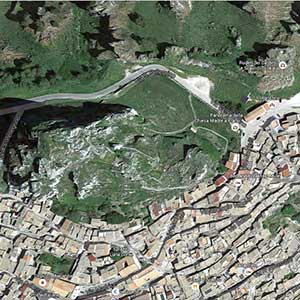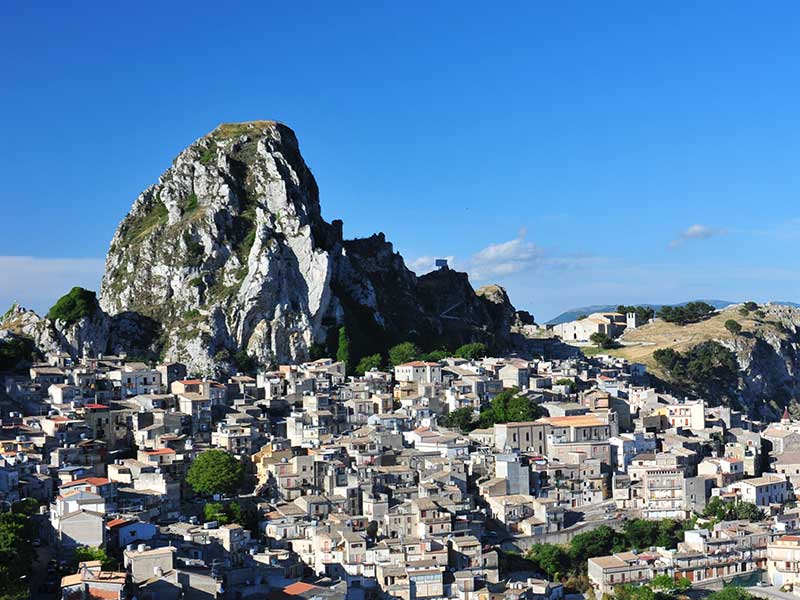Maps

Testi concessi dall'Archeologa Patrizia Noto

SiciliaAntica
Associazione per la tutela e la valorizzazione dei Beni Culturali ed Ambientali

Testi concessi dall'Archeologa Patrizia Noto

SiciliaAntica
Associazione per la tutela e la valorizzazione dei Beni Culturali ed Ambientali

Il monte prende il nome dai resti del castello edificato in età normanna nella sua punta più piccola e del quale ancora oggi possiamo scorgere i resti della torre di accesso, torre che rivestiva funzione di porta fortificata disposta su tre piani. La punta più alta del monte, un piccolo spiazzo, presenta una piccola fortificazione quasi del tutto scomparsa ed una cisterna che distribuiva acqua. Tutt’intorno al monte gira una muraglia che a tratti ha un’ottima manifattura riconducibile ad età romana, la restante cinta muraria presenta una fabbricazione meno curata di età normanna. Il Castello fu teatro di un numero elevato di assedi e rifugio della regina Sibilla, che ivi si nascose nel 1194 per sfuggire all’imperatore Enrico VI di Svevia. In una miniatura del XII secolo la regina Sibilla (l’ultima regnante normanna) è raffigurata sofferente e sporta da una finestra del castello; dalla miniatura si desume l’esistenza di un castello in età normanna, ma la sua presenza la si riconduce a Dedalo, ingegnoso architetto che aveva scelto questo monte per creare, con accessi tortuosi ma facilmente difendibili da soli tre uomini, il palazzo di un potente re sicano.

The mount is named after the ruins of the castle built during the Norman age on the smallest end of the mount. What is left of the old castle is the ancient entrance tower, serving as a fortified portal on three levels. Through the door the old fortification is visible, although it is mostly gone, and what is was a reservoir for fresh water. All around the mount there are traces of a Roman era wall, well manufactured, with the remaining walls of more recent Norman age, less perfect than the older one. The Castle was the theatre where several sieges took place. It was a temporary shelter of Sybilla, Queen of Jerusalem, when she was forced to hide from the emperor Henry VI of Swabia. In a miniature from the XII century, Queen Sybilla, the last of the Normans rulers, is shown suffering, leaning out from a window of the castle; from the same miniature, it could be inferred that there was also, at some point in time, a castle, during the Norman years, but its presence is linked to Daedalus. It was him the ingenious architect who chose this mount to create a palace for an important Sican King, difficult to construct but easy to defend by as few as three men.

El monte lleva el nombre de las ruinas del castillo construido en la época normanda en el extremo más pequeño de la montura. Lo que queda del antiguo castillo, es la antigua torre de entrada, que actúa como un portal fortificado en tres niveles. A través de la puerta de la antigua fortificación es visible, a pesar de que casi ha desaparecido, lo que era un deposito de agua dulce.
En todo el monte hay vestigios de un muro de época romana, bien fabricados, los restos más reciente de las paredes datan de la edad de los normandos, menos perfecta que la anterior. El castillo fue el escenario donde tuvieron lugar varios asedios. Era un refugio temporal de Sybilla, reina de Jerusalén, cuando se vio obligada a esconderse del emperador Enrique VI de Swabia. En una miniatura del siglo XII, la reina Sibila, la última gobernante de Normandia, muestra su sufrimiento, asomándose desde una ventana del castillo, de la misma miniatura. Se podría inferir que también hubo, en algún momento en el tiempo, un castillo, durante la epoca de Normandia, pero su presencia está ligada a Dédalo, el ingenioso arquitecto que eligió este montaje para crear un palacio para el importante rey Sicán, difícil de construir pero fácil de defender por tan sólo tres hombres.

Der Berg hat den Namen von den Resten der normannischen Burg an seiner kleineren Spitze, von der wir auch heute noch Teile des Turms und der Befestigung erblicken können.
Die höchste Spitze des Berges, ein kleiner Platz, wies eine kleine, fast vollständig verschwundene Befestigung und eine Zisterne zur Wasserversorgung auf. Um den Berg herum verläuft eine Mauer, einer römischen Machart ähnlich, die restlichen Mauern repräsentieren normannische Manufaktur. Die Burg war der Schauplatz einer großen Anzahl von Belagerungen und im Jahre 1194 suchte dort die letzte Normannenkönigin Sibilla Zuflucht vor Kaiser Heinrich VI. von Schwaben. In einer Miniatur aus dem XII. Jahrhundert wird Sibilla an einem Fenster der Burg dargestellt.